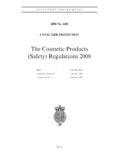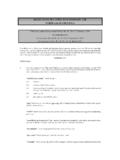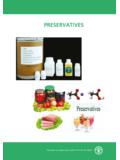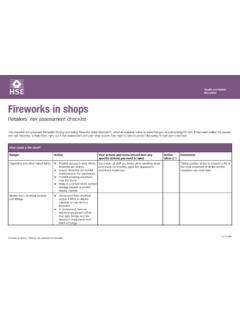Transcription of On the environmental regulation of wood - TIMCON
1 On the environmental regulation of wood Summary This document explains when the Environment Agency will consider wood to be a waste, what regulatory controls should be followed and our recommendations to industry. The document deals with virgin timbers and non-virgin timbers. Virgin timber is of the type from forestry works or virgin wood processing such as wood off cuts, shavings or sawdust from sawmills or timber product manufacture dealing in virgin timber or cuttings and brash from tree felling or other forestry management operations. Non-virgin timber is generally considered either to be treated or clean. Clean timber includes any timber or timber product, which has not been treated.
2 Treated timbers include any timber or timber product, which may have been chemically treated to enhance or alter the performance of the original wood. Treatments may include penetrating oils, tar oil preservatives, waterborne preservatives, organic based preservatives, boron and organo-metallic based preservatives, boron and halogenated flame retardants and surface treatments. Note that references to types of waste wood or their uses are not intended to be exhaustive and any waste type or use not mentioned may be subject to control and you should contact us for further guidance. Background Under the guidance of the Waste Protocols Project1 a technical advisory group, comprised of Environment Agency, WRAP and Industry representatives produced a technical report to consider the circumstances when wood ceased to be waste and to consider whether a Quality Protocol could be developed.
3 The report identified many information gaps concerning what systems of quality control should be put in place and what standards should be adopted when reprocessing waste wood in order to ensure that the outputs do not pose a risk to human health or the environment. For this reason it has not been possible to produce a Quality Protocol which would identify the point at which waste wood may cease to be waste. Instead, we have produced this position statement to provide clarity on how wood is regulated by the Environment Agency. Further details on this and guidance on regulatory controls can be obtained from our National Customer Contact Centre on 08708 506 506 or from our website at 1.
4 The waste protocols project is a joint Environment Agency and Waste Resources and Action Programme (WRAP) initiative, funded by the Department for the Environment, Food and Rural Affairs (Defra) Business Resource Efficiency and Waste (BREW) Programme. Environment Agency position Virgin timbers are not waste and will not be subject to waste regulatory controls provided that they are certain to be used for the purposes to which virgin wood is commonly put. These uses include use as woodchip in gardens or on pathways, as a raw material for composting, as animal bedding, as fuel in an appliance or as a raw material for the production of wood based products or in paper production.
5 However, if virgin timber is mixed with waste timber, it will all be classed as waste. Non-virgin timber off cuts, shavings, chippings or sawdust from the processing of non-virgin timbers are waste and are subject to waste control; the type of control will vary depending on the intended use, some examples are given below. Relevant acronyms are explained in Appendix 1. - Use in wood based panel manufacture - the wood will remain waste until it is made into the panelboard and must be stored and processed into panelboard in accordance with either a WML, an IPC or PPC permit - Use in landscape applications such as weed suppressant, decorative woodchip, pathways, arena chip.
6 The material must be stored and applied to land in accordance either with a WML or Paragraph 7A exemption. - Use in animal bedding such as cattle, horse, pet bedding. The material must be stored and used in accordance either with a WML or the exemption from licensing contained in Paragraph 15 of the WMLR. - Use as fuel the material can be burnt. Its burning is normally regulated under WID. However, if it can first be shown that it is not contaminated with halogenated organic compounds or heavy metals (resulting from treatment with wood preservatives or coating), WID does not apply. In such circumstances, the material remains waste until it has been burned as a fuel, and its burning may still be subject to PPC or WMLR.
7 It must be stored and burned in accordance either with a PPC permit or (for very small appliances) under the exemption from waste management licensing contained in Paragraph 5 WMLR. - Used to make compost - Compost must be stored and composted in accordance with either a WML or the exemption in Paragraph 12 of the WMLR. If the compost complies with the Quality Protocol produced by WRAP and the Environment Agency2 for the production and use of quality compost from source-segregated biodegradable waste, the material will cease to be waste when the compost has been produced, and waste regulatory control will cease at that point. If the compost does not comply with the Quality Protocol, it will remain waste until the compost has been applied to land.
8 The compost must then be transported to the place where it will be used by a registered Waste Carrier it must be stored and applied to land in accordance either with a WML or the exemption from licensing contained in Paragraph 7A of the WML. 2. Environment Agency recommendations to Industry The information contained in the technical report was insufficient to give us confidence that all non-virgin clean timber is clean enough and we will continue to classify it as To move beyond this point and give greater certainty to the wood recycling industry we recommend that they develop an approved standard with appropriate certification and accreditation systems that will: specify minimum quality controlled production processes which will be used; and identify the point at which the output can be verified as free from (or have an acceptable level of) contaminants.
9 We may then be able to agree a Quality Protocol indicating when clean non-virgin timber is considered to be fully recovered and ceases to be waste. We recognise that wide variability exists in specifications used in waste wood markets. As the market for waste wood products develops it will remain an option for companies to make a case to us that the waste wood has been fully recovered to a standard that can be widely marketed as a product. Such submissions will be considered on a case by case basis to encourage higher standards to prevail. Appendix 1: Summary regulatory controls The environmental Protection Act 1990 and Waste Management Licensing regulations 1994: If you keep, treat or dispose of waste wood you will need to obtain a waste management licence (WML) or register an exemption unless your activity falls within one of the low risk Environment Agency positions mentioned below.
10 All these exemptions must be registered with the Environment Agency. This can be done through our customer service line and are free apart from paragraph 7A. The following exemptions are the most likely to be relevant: Paragraph 3 Burning wood as a fuel under a local authority authorisation Paragraph 5 Burning waste as a fuel in an appliance subject to thermal input Paragraph 7A Spreading wood waste on specified land for agricultural benefit or ecological improvement Paragraph 12 Composting biodegradable waste Paragraph 13 Manufacture of timber products from waste wood Paragraph 15 Beneficial use of waste Paragraph 21 Chipping, shredding, cutting or pulverising waste plant matter Paragraph 30 Burning waste plant tissue on specified land in the open More information about applying for a licence or exemptions can be found at Permits.






